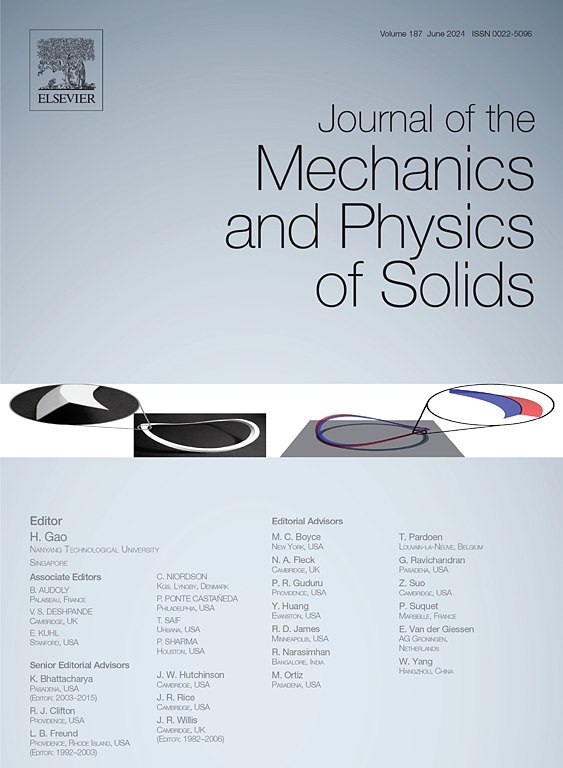ENNStressNet - An unsupervised equilibrium-based neural network for end-to-end stress mapping in elastoplastic solids
IF 5
2区 工程技术
Q2 MATERIALS SCIENCE, MULTIDISCIPLINARY
引用次数: 0
Abstract
Determining internal stress and strain fields in solid structures under external loads has been a central focus of continuum mechanics, playing a critical role in characterizing the mechanical behaviors and properties of both engineering and biological systems. With advancements in modern optical and electron microscopy techniques, strain fields can now be directly measured using sophisticated methods such as digital image correlation and digital volume correlation. However, direct measurement of stress fields remains limited to simple cases, such as photoelastic tests and standard uniaxial or shear tests. For elastoplastic solids, which exhibit complex irreversible and history-dependent deformations, stress fields are typically inferred through numerical calculations based on empirical constitutive models that are not always reliable or even available. Here, we introduce an unsupervised equilibrium-based neural network (ENN) that is trained using readily measurable strain fields and forces from a single specimen to directly predict the internal stress field. The ENN's structure aligns with the general framework of the incremental theory of elastoplasticity, without requiring prior knowledge of its detailed mathematical form. Once trained, the ENN, referred to as ENNStressNet, serves as an end-to-end stress mapper, enabling the direct determination of stress fields from measured strain fields in elastoplastic solids with arbitrary geometries and under various external loads. This approach thus bypasses the need for constitutive modeling and numerical simulations in conventional engineering analysis.
基于无监督平衡的神经网络,用于弹塑性固体的端到端应力映射
确定固体结构在外部载荷作用下的内应力和应变场一直是连续介质力学的中心焦点,在表征工程和生物系统的力学行为和特性方面起着至关重要的作用。随着现代光学和电子显微镜技术的进步,现在可以使用数字图像相关和数字体积相关等复杂方法直接测量应变场。然而,直接测量应力场仍然局限于简单的情况,如光弹性试验和标准单轴或剪切试验。对于表现出复杂不可逆和历史相关变形的弹塑性固体,通常通过基于经验本构模型的数值计算来推断应力场,这些模型并不总是可靠的,甚至是可用的。在这里,我们引入了一种基于无监督平衡的神经网络(ENN),该网络使用易于测量的应变场和来自单个试件的力进行训练,以直接预测内部应力场。ENN的结构与弹塑性增量理论的总体框架一致,不需要事先了解其详细的数学形式。经过训练后,ENN(称为en应力网)可以作为端到端应力映射器,通过测量任意几何形状和各种外部载荷下的弹塑性固体的应变场,直接确定应力场。因此,这种方法绕过了传统工程分析中本构建模和数值模拟的需要。
本文章由计算机程序翻译,如有差异,请以英文原文为准。
求助全文
约1分钟内获得全文
求助全文
来源期刊
CiteScore
9.80
自引率
9.40%
发文量
276
审稿时长
52 days
期刊介绍:
The aim of Journal of The Mechanics and Physics of Solids is to publish research of the highest quality and of lasting significance on the mechanics of solids. The scope is broad, from fundamental concepts in mechanics to the analysis of novel phenomena and applications. Solids are interpreted broadly to include both hard and soft materials as well as natural and synthetic structures. The approach can be theoretical, experimental or computational.This research activity sits within engineering science and the allied areas of applied mathematics, materials science, bio-mechanics, applied physics, and geophysics.
The Journal was founded in 1952 by Rodney Hill, who was its Editor-in-Chief until 1968. The topics of interest to the Journal evolve with developments in the subject but its basic ethos remains the same: to publish research of the highest quality relating to the mechanics of solids. Thus, emphasis is placed on the development of fundamental concepts of mechanics and novel applications of these concepts based on theoretical, experimental or computational approaches, drawing upon the various branches of engineering science and the allied areas within applied mathematics, materials science, structural engineering, applied physics, and geophysics.
The main purpose of the Journal is to foster scientific understanding of the processes of deformation and mechanical failure of all solid materials, both technological and natural, and the connections between these processes and their underlying physical mechanisms. In this sense, the content of the Journal should reflect the current state of the discipline in analysis, experimental observation, and numerical simulation. In the interest of achieving this goal, authors are encouraged to consider the significance of their contributions for the field of mechanics and the implications of their results, in addition to describing the details of their work.

 求助内容:
求助内容: 应助结果提醒方式:
应助结果提醒方式:


